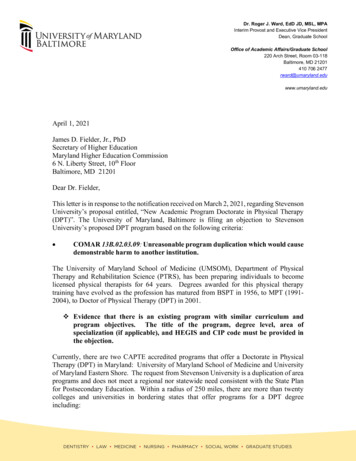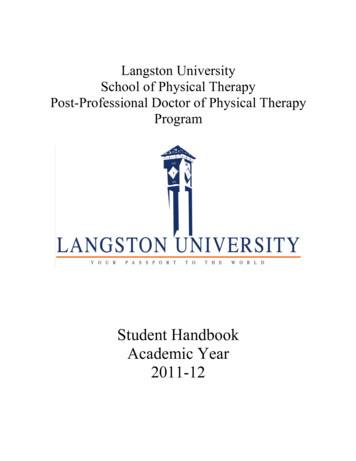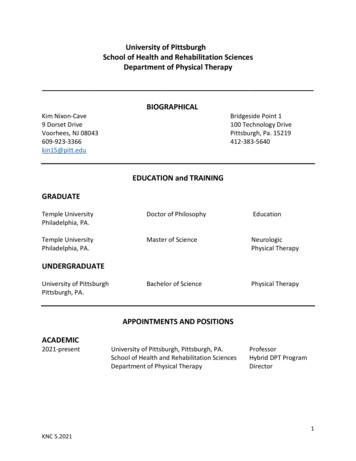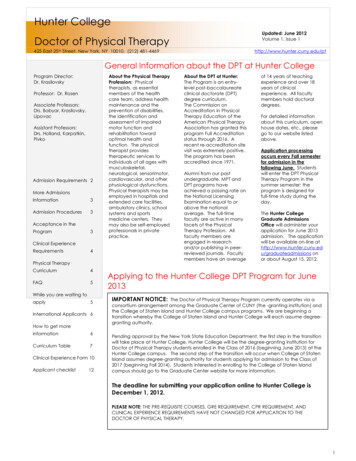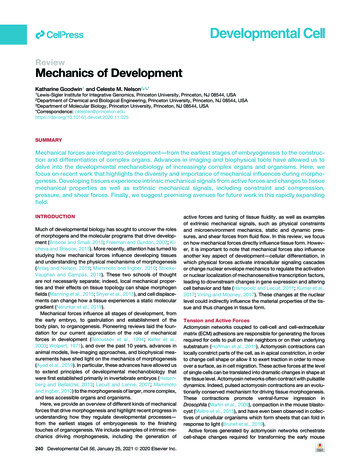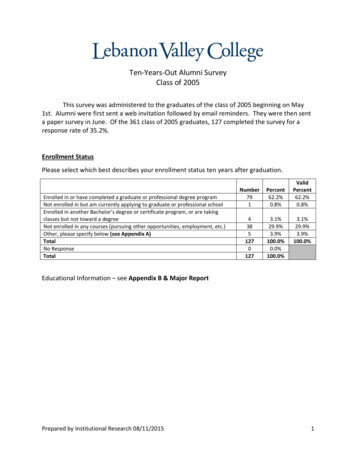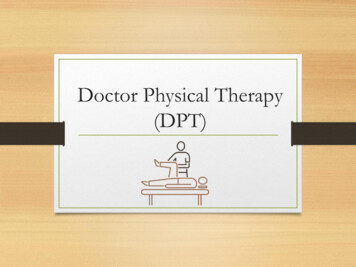
Transcription
Doctor Physical Therapy(DPT)
What is physical therapy? Physical therapy is a type of treatment you may need when health problems makeit hard to move around and do everyday tasks. It helps you move better, improvesor restores your physical function and fitness level, and may relieve pain. The goal of physical therapy is to make daily tasks and activities easier. For example, it may help with walking, going up stairs, or getting in and outof bed. Physical therapy can help with recovery after some surgeries. A doctor maysuggest physical therapy for injuries or long-term health problems such as arthritisor chronic obstructive pulmonary disease (COPD). Physical therapy may be used alone or with other herapy-topic-overview
Who are physical therapists? Physical therapists (PTs) are highly-educated, licensed health care professionalswho can help patients reduce pain and improve or restore mobility - in many caseswithout expensive surgery and often reducing the need for long-term use ofprescription medications and their side effects. Physical therapists can teach patients how to prevent or manage their condition sothat they will achieve long-term health benefits. PTs examine each individual anddevelop a plan to prevent the loss of mobility before it occurs by developingfitness- and wellness-oriented programs for healthier and more active lifestyles. State licensure is required in each state in which a physical therapist practices.APTA.org/AboutPTs/
Where do physical therapists practice?Although many physical therapists practice in hospitals, more than 80% practice in: Outpatient clinics or officesInpatient rehabilitation facilitiesSkilled nursing, extended care, or subacute facilitiesHomesEducation or research centersSchoolsHospicesIndustrial, workplace, or other occupational environmentsFitness centers and sports training facilitiesAPTA.org/AboutPTs/
Key Players in DPT History Dr. James Cyriax (1904-85): orthopedic surgeon fromEngland who developed simple objective clinical exams thatwould effectively diagnose soft tissue lesions. The system thathe developed has helped shape the way physical therapistsevaluate patients. He passed away in 1985 at the age of 80. Florence Kendall: a physical therapist since the early1930’s, she wrote the seminal book “Muscles: Testing andFunction With Posture and Pain.” This book is used inphysical therapy education programs as well as in practicethroughout the world. She passed away in 2006 at the ageof 95.jointventurespt.com/blog/key-people-in-physical
Do you have what it takes? Do you have the excellent communication skills required for teachingpatients, interacting with other health professions, and participating as acollaborative partner on a patient-centered health care team? Are you genuinely caring and compassionate about making adifference in the lives of others, whether it be in their overall health andwellness or in providing rehabilitation for an injury, genetic disorder, orchronic condition? Are you committed to maintaining lifelong learning to ensure that yourknowledge and skills are contemporary in the interest of providingevidence-based care and best practices to meet the needs ofpatients/clients? Can you be flexible to changes at the micro and macro levels withorganizations and health care systems?APTA.org/AboutPTs/
Preparing for the Admissions Process Explore PT programs to determine the ones that may best meet your educational needs.Complete course prerequisites for your designated programs.Obtain physical therapy experience and have your hours verified by a PT, ifrequired by your designated programs. Many programs have a minimumnumber of hours required.Take the Graduate Record Examination (GRE) at least 6 weeks before theapplication deadline.Submit the completed application EARLY and before the program’s deadline.Some programs use a rolling admissions process, so if you apply earlier, yourchances of acceptance are higher.PTCAS applicants should also review the PTCAS PTProcess/
Course PrerequisitesAccording to the APTA (American Physical Therapy Association): a particular collegemajor is not required and course prerequisites vary significantly across different PTeducation programs.The following are the most common: Anatomy/A&P 1 with lab Biology 1 (not botany or zoology) General Chemistry 1 with lab General Physics 1 with lab Psychology Physiology/A&P 2 with labBiology 2 (not botany or zoology)General Chemistry 2 with labGeneral Physics 2 with labStatisticsSee PTCAS Course Prerequisite Summary for a list of DPT education programs, andtheir requirement ns/PTProcess/
Most common majors for acceptedapplicants (2015-2016)PTCAS.org
Physical Therapy Professional Schools If you enter after earning a Bachelor’s degree, the program will most likely be three years, year-round.You will have some classroom work, a lot of lab time, as well as multipleinternships to gain hands-on experience.A few programs offer specialized “tracks” but all will also train you to be ageneralist who can practice in any setting.After you complete the requirements, you will earn a Doctorate in PhysicalTherapy (DPT).Some DPTs opt to complete a voluntary residency after completing theprofessional school program.The median annual salary for a DPT in 2016 was -therapists.htm#tab-5
Sample Graduate PT Programs University of DelawareUniversity of PittsburghUniversity of Southern CaliforniaWashington University in St. Louis Northwestern University University of IowaMGH Institute of Health ProfessionsU.S. Army-Baylor UniversityDuke UniversityFind a program near you in the CAPTE Program th-schools/physical-therapy-rankings
Sample Curriculumfrom USC Division of Biokinesiology and Physical TherapyYear 1FallSpringSummer AEvidence for Physical Cellular & SystemsTherapist PracticePhysiologyMechanics of HumanGaitDisorders of theEvidence for PhsicalTherapeutic Exercise Analytical Anatomy Clinical BiomechanicsMusculoskeletalTherapist PracticeSystemPrinciples of DiseaseMusculo-skeletalAnatomyBasics of PatientManagementSpecial Topics in Therapeutic ExerciseSummer BClinical Imaging2-Week MidtermClinical PracticumClinical Management ofMusculoskeletalDysfunctionTherapeutic Application of Physical Agents6-Week Clinical AffiliationYear 2FallNeuro-anatomyPathology of CardioPulmonary & FundamentalsSummer ASummer BPharmacologyClinical ExercisePhysiologyClinical Managementof NeurologicDysfunctionClinical Electrophysiology2Clinical ManagementWeek Midterm Clinic Evidence for Phsycialof Cardio-PulmonaryTherapist PracticealDysfunctionPracticumWeekEvidence for PhysicalMidterm ClinicalTherapist PracticePracticum6-Week Clinical AffiliationLifespan Motor ControlEvidence for Physical Therapist PracticeDifferential Diagnosis in Physical TherapyYear 3ABIntegrated Management ofthe Upper & LowerExtremityIntegrated Management of the AxialSkeleton System & Related MovementDisordersIntegrated Patient Management Seminar16-Week Part-Time Advanced ClinicalClerkship with Academic Integration16-Week Full-Time Advanced Clinical rapy/DPT/Curriculum/
Defining MomentsInspiring stories of particular moments or incidents that have led people to acareer in physical therapy or reinforced why he or she became a physicaltherapist or physical therapist assistant. Read the columns or download thepodcasts. September 2017: Forged on the Battlefield: A New Mission A veteran'scareer path began in Afghanistan. July 2017: Amputation and Ambulation A youth's fear becomes a PT'spassion. June 2017: Modern Science, Ancient Practice Physical therapy andyoga, working together for patients.apta.org/DefiningMoment/
For Additional Information APTA video detailing the diversity of PT practice settings:https://www.youtube.com/watch?v r35FQT3u0J4 American Physical Therapy Association: APTA.org Commission on Accreditation in Physical Therapy Education: CAPTEOnline.org Move Forward: MoveForwardPT.com Physical Therapist Centralized Application Service: PTCAS.org
The goal of physical therapy is to make daily tasks and activities easier. For example, it may help with walking, going up stairs, or getting in and out of bed. Physical therapy can help with recovery after some surgeries. A doctor may suggest physical therapy for injuries or l
